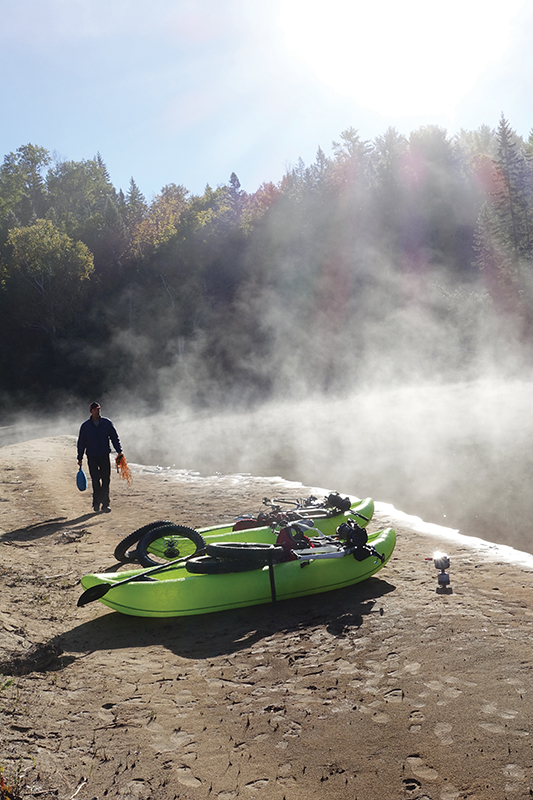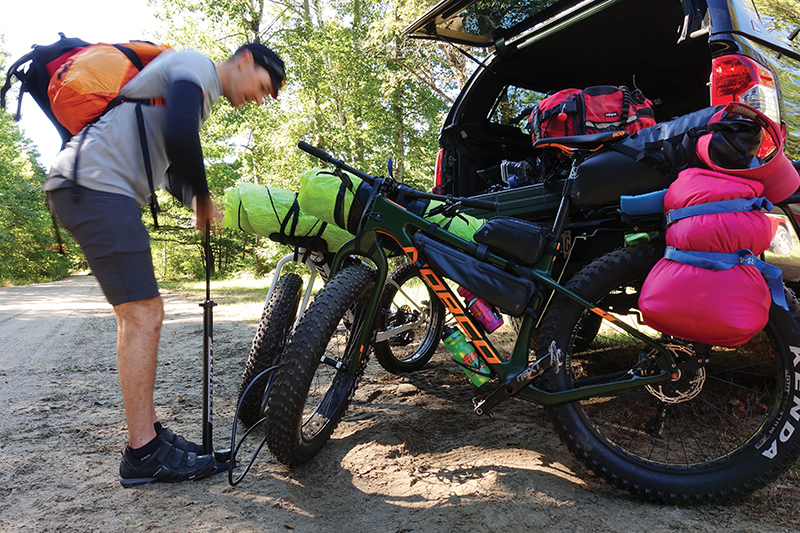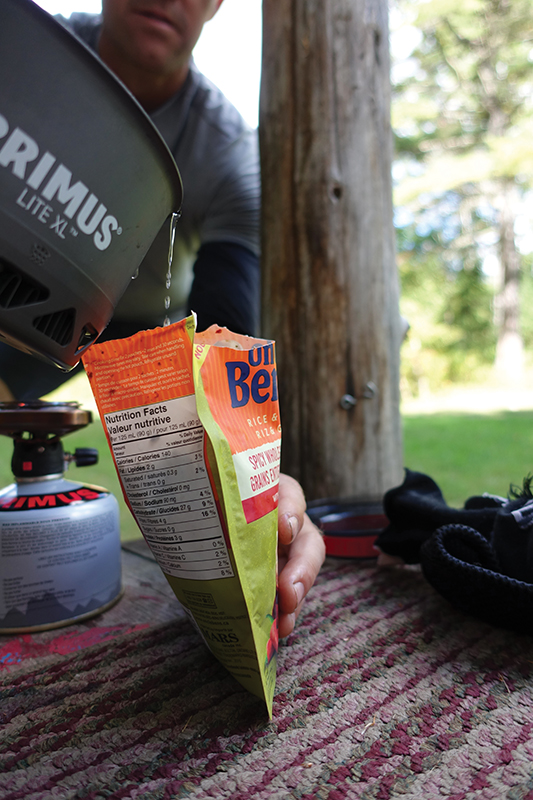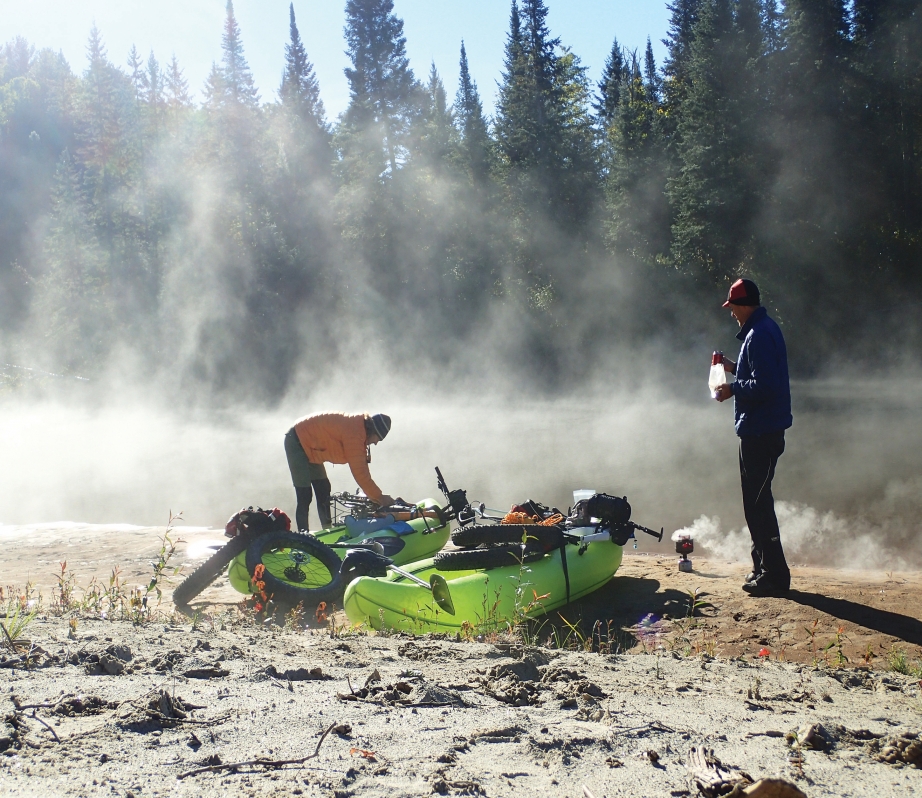I arrive after dark on Friday evening to find Cam in his basement bike shop gear room making last minute adjustments to our menu. A leftover box of Halloween candy bars sits on his workbench beside mesh bags full of one pot Uncle Ben’s instant rice and foil wrapped strawberry Pop-Tarts.
I’m new to bikepacking. In fact, I haven’t even been backpacking since freshman year at university. I remember thinking even then that backpacking felt like a four-day-long portage.
I’ve just come off a multi-day river trip where three families shared two 120-liter coolers of food and a two-burner propane range lashed to raft frames. We’d grilled fresh steaks, baked cakes in cast iron Dutch ovens and the parents enjoyed tall-boys of local microbrews.
Cam handed me a mesh bag smaller than the lunch box I take to the office. He clearly misunderstood the look on my face, because he said, “I know, I packed us extra meals in case we have to spend another night.”
Realizing this was my food for the entire trip, I reached for the box of bite-sized Snickers and Mars bars and filled my pockets.
Cameron Dubé pitched a bikepacking packrafting story to Rapid. I’d just returned from a tradeshow where AIRE had revealed their new BAKraft Expedition packraft. Norco Bicycles had just sent out preproduction information on their new Ithaqua fatbike. And because my dad died in the spring, I’d gotten to only a few of the river trips on the list beside my bed. I needed an adventure.
Before any of the other editors could respond to Cam’s query, I wrote to tell him I was interested and that I’d source boats if he’d organize the food. I received a thumbs up emoji and one word: “Where?”

The criteria we set for the trip seemed reasonable. The whitewater couldn’t be lame. It also couldn’t be over the top hard either—we hadn’t test paddled or even inflated the boats. It also had to be real adventure. The idea of bobbing down and sleeping over on a popular run that could be shuttled in a Civic and knocked off in an afternoon seemed silly. Why bother with fat bikes and camping gear?
As autumn crept toward winter we added one more criteria. We had the same window that most other dudes with jobs have—Friday after work to Monday morning.
Hidden in the woods between Grant Settlement Road and the river right bank of the whitewater section of the Ottawa River there is a spider web of purpose-built singletrack mountain biking trails. Cam will say dozens of dedicated volunteers cleaned up trash, cut and shoveled sections of rocky and root-filled trails and donated sweet treats for bake sale fundraisers. Those of us who ride these trails know that Cam has been the driving force behind creating a local mountain bike scene in a farming and rafting town.
Cam and I have an hour to chat about the early days of the Beachburg Off Road Cycling Association while we drive from his home in Beachburg, Ontario to Rivière Noire on the Quebec side of the Ottawa River where we decided our weekend adventure would begin.
The Noire River is a staple weekend to seven-day whitewater canoe trip. Black Feather has been operating here since the 1980s.
Depending on the time of year, the Noire is roughly 240 kilometers of runnable class I-III wilderness river. The Noire is the lesser-known sister to the Coulonge and Dumoine rivers that Black Feather describes as, “The longest distance of runnable whitewater, the shortest distance that must be portaged, the best chance of seeing wildlife, and the smallest possibility of encountering other paddlers.”
Perfect.
We arrive at the Black River Inn where we park beside only one other car and begin unloading. John Perron wanders down to check out our fat bikes and collect the $20 fee for parking.
“As far as I know there is only one other group on the river. You’ll probably be the last until spring,” he tells us while the contents of my pickup truck get stuffed and strapped to our bikes.
The Black River Inn and the bridge we use to cross the river were built 100 years ago in the boom of the lumber industry that opened this entire region. The Inn looks abandoned, or at least like it’s taking a nap in the quiet time between canoe shuttles and the upcoming frenzy of deer hunting season.

Cam has his bike packing systems down to a science.
Serious bikepackers these days are doing away with the traditional rack and panniers system used for road touring in favor of keeping everything in-line. Bags are shaped to fill all the nooks and crannies created by the frame, handlebars and seat. Cam uses a custom-made frame bag lashed in the main triangle of the bike to stow all the heavy things.
“You want to keep as much weight as you can low and center on the bike,” he tells me. The bag swallows our one-burner propane stove, fuel canisters, cook set and his small bundle of food.
Beneath our seats hangs another 18 liters of storage we use for our sleep systems, which would normally hang across the front of the handlebars. Except on this trip that’s where we carry the packrafts. On the top tube at Cam’s handlebar stem is a snack pouch full of trick-or-treat candy bars. We shoulder daypacks to carry our PFDs and other odds and ends.
When it comes to paddling and biking gear, we realize some things have to work double duty. Our bike helmets will be fine as paddling helmets. Our sticky rubber bike shoes will make do as river shoes. Paddling jackets become riding shells. There isn’t room for both.
The logistics of the river trip are remarkably simple. Park at the take-out. Ride some 35 kilometers up the river. Paddle back to the truck. What we hadn’t considered is that roads are created as the shortest distance between two points. Rivers find the windiest route of least resistance. And bikes roll faster than kayaks can be paddled.
By lunchtime, and after three stops to pick up gear rattling off my bike, we nail our packing systems and are rocketing long gravel descents, popping off rollers, splashing through puddles and crawling over beaver dams like on any Saturday afternoon ride.
The whole fat bike bikepacking thing is relatively new. While the first Iditabike backcountry race in Alaska was way back in 1987, fat bikes lived in relative obscurity, like telemark skis and squirt boats, until 2010 when a couple boutique bike brands released complete models to mainstream bike shop distribution channels.
Finally in 2014, Specialized released their Fatboy. What was once thought a fad or niche was being picked up by the major bike manufacturers. That fall I jumped on Norco’s new Big Foot and declared “I will never buy a fat bike.”

The first fat bikes were heavy and pokey. The geometry was weird. I couldn’t have imagined riding two kilometers of singletrack let alone 1,000 miles through frigid God’s country, Alaska. Cam on the other hand, was an early adopter.
“I just found the fat bike to be the perfect all-round mountain and, year-round bike,” he tells me. “If I want to race there are fat bike categories. I can be fast on trail rides. And if I want to go on adventures like this I can do it all on one bike.”
Granted, technology has come a long way in the last few years. The new Norco Ithaqua is a full carbon-fiber 26-pound fat bike, as is Cam’s Fatboy. Cam also has carbon wheels on his, which drops his fat bike to about the same weight as most cross country race bikes. Fat bikes are now, dare I say, sexy.
I was too busy with deadlines so I left the route planning all to Cam.
He figured if we kept the river on our right-hand side we couldn’t get lost. Whatever trails we use will eventually feed into a main logging road that crosses another bridge over the Noire. Once on the river, we will paddle until we come to the bridge at the Black River Inn. Seemed reasonable.
The original plan was to ride one day and paddle back the next. We arrive at the put-in mid-afternoon and are excited to try the boats, so decide to put on the river. It was a good thing we did.
I didn’t know Cam hadn’t packed a map until we began inflating the boats and disassembling our bikes.
“So, how far is it back down to the truck?” I ask.
He said he couldn’t remember the exact number of river miles, “But it’s all downhill.”
I smile and squeeze another bag of air into the boat.
To keep the pack weight to a minimum, AIRE’s storage bag comes with a hose and doubles as an inflater. Fill the bag with air and squeeze it through the hose into the raft. It’s a clever but tedious system. Cam and I decide on the next trip we’ll pack a small hand pump, in which we’ll also store the repair kit, bike tools and spare parts.
All told, in less than an hour we completely change sports and shove off from our sandbar and spend the last couple hours of daylight munching on Snickers bars meandering past beachy sandbars and log jams left by the last spring flood.
“How much further do you think we should go today?” I ask Cam for the second or third time as we float past another exotic white sandbar
“We can probably stop anytime,” he says.
Without a map, he really doesn’t know. And I really don’t care. We are enjoying the trip and only have to set out our sleeping bags and boil water for our one-pot dinners. And so we shrug at each other and keep paddling.
Hap Wilson’s book, Rivers of the Upper Ottawa Valley, is the go-to river guide for the Dumoine, Coulonge and Noire rivers. Wilson’s hand-drawn maps have inspired and guided thousand of canoeists down these rivers. Originally published in 1993, Wilson’s guide predates the new logging road and bridge now at his Rapid #43, the access point we used to begin our trip. Even if we’d brought his book we wouldn’t really know how high up the river we started.
As the warmth of the afternoon sun dips below the autumn trees, we scrub the bows of our packrafts on the sand and reach for our wooly hats and puffy down sweaters.
One thing I learn about bikepacking and packrafting is that it doesn’t take long for meals.
Cam has an Excel spreadsheet charting the caloric value of food to weight ratio. When you’re winter endurance racing it is about lots of calories fast to stay warm while carrying as little as possible. Dinnertime goes something like this: Boil water. Pour water into bags and seal. Put bags of boiling food in inside jacket pockets like Ziploc hot water bottles. Enjoy warmth for three to five minutes until ready to serve.
After pasta we build a fire with bits of driftwood we find on the beach. The stars are out and it is dark by 6:30 p.m.
We guess we traveled five or six of the estimated 40 kilometers and we’ll soon catch up to the faster moving water and rapids that make the Noire such a popular whitewater run.
Soon after the Second World War inflatable packable rafts used as survival equipment in airplanes began to appear in army surplus stores. Legend has it that in 1952, Dick and Isabelle Griffith did the first recorded whitewater packraft river run when they descended Copper Canyon in Mexico.
Sixty-five years later, packrafting seems like it’s the new big thing. Companies like Alpacka, Kokapelli and AIRE all making whitewater-specific lightweight inflatables that you can carry up rivers and paddle back down.
Packrafts fall into two categories. Ones you’d take into whitewater and ones you wouldn’t, or at least shouldn’t. While materials continue to improve, there will always be a compromise between weight savings, durability and size.
In the morning, Cam and I rig our boats like we would whitewater rafts—we rig to flip. The wheels off and stacked on the bike frames, we strap everything down tightly and independently of the bags below. We move our seats one loop more forward and lash a dry bag at our feet to better level the trim. Typically in packrafts the bikes would be laying across the bow over top of our legs. We are happy to have opted for AIRE’s new 10-foot-long BAKraft Expedition. The extra room to put the bikes behind us makes for easier paddling and seeing our lines down the rapids ahead.
We approach each set like early explorers traveling in Kermit the Frog-green space-age crafts. We boat scout everything we can see from the river. We stretch our legs and look at what we’d later learn were 50:50 Rapids, Manitou Rapids and Rapid #46, the slightly more technical class IIIs.
After the first few rapids we had all but forgotten about being in packrafts. If we didn’t once in a while bump our elbows on pedals and crank arms, we’d forget about the bikes too. We run the river like in any other kayak looking for the fun deep tongue lines and eddies along the way.
We’d been paddling a solid seven hours when it starts to get dark. The fading light isn’t enough for us to distinguish deep water from the shallow pillows in the boogie water swifts.
“How much abrasion do you think these floors will take,” I shout over to Cam. We are both scrubbed up on the rocks hidden just below the inky surface. I feel like we are kids at a birthday party knocking around balloons, our parents waiting for them to pop but never they do.
Three hours after dark, and two hours after I’d told my wife I’d be back home, we round another lazy bend and can see what would be the lights of the Black River Inn. Two hours ago we made satellite phone calls home. We’d inventoried our food that included two Clif bars, a half bag of hot cereal and four mini Snickers between us. Enough for a late dinner and breakfast, or so we said on the phone.
When we arrive at the crumbling concrete steps below the timber frame bridge of the Black River Inn, the light rain that has been falling turns to snow. We wet and melt the frozen cam straps holding our bikes in place. We are surely the last travelers down the Noire for the year and likely the first self-supported fat bike packraft trip the river has ever seen.
In silence we deflate and roll our boats. We assemble and load the bikes on the racks. And then crawl into the cab of the warm truck for the ride home.
“Well, that was super fun. We should do more of those,” I say finally as the truck tires roll from gravel to the tarmac two-lane secondary highway.
Cam gives me a real thumbs-up and asks, “Where?”
Scott MacGregor is the founder and publisher of Rapid. He lives in the Ottawa Valley with his wife, two children and his new carbon-fiber fat bike.





Thank you for the above article really enjoyed reading it and thanks for all you do and articles for the magazine and e-mails etc makes my day to read them I reside in st. petersburg Fl. and have been sea kayaking for over 30 years and a very ammature white water kayaker I will be turning 75 soon my ability to do eather is very limited so enjoy reading about you alls adventure so thanks again for all you do and your article on paddling so as roy rogers and dale evens closing song use to be ( your mush to young to remember them ) happy trails ( peddling and paddling that is ) to you until we meat again Sincerely kenny hillier